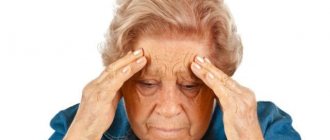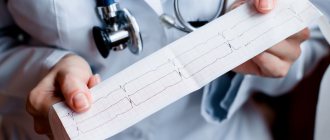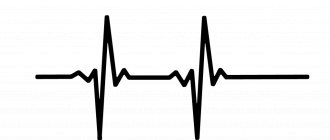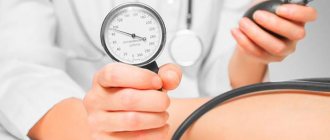Fainting (an outdated medical name is syncope) is a condition characterized by loss of consciousness and a drop in blood pressure. Metabolism slows down, sudden weakness and confusion occur. Fainting can last from a few seconds to tens of minutes.
In most cases, fainting is caused by a sudden decrease in metabolism in the brain, cerebral circulation is disrupted, and the brain stops receiving enough oxygen. Despite the fact that the brain does not function at full capacity, basic vital functions are reduced, but do not disappear completely. The patient is breathing, the heart is working.
Loss of consciousness can be caused by a variety of diseases. Sometimes fainting occurs due to a coincidence of circumstances - fatigue, stuffiness, prolonged fasting.
Before fainting, there is always a pre-fainting state, which can also last from a few seconds to several minutes. In some cases, it is enough for the patient to sit or lie down and relax the collar to avoid fainting.
Presyncope is characterized by the following symptoms:
- pulsation in temples;
- difficulty breathing - a subjective feeling of lack of oxygen;
- increased sweating;
- feeling of heat throughout the body;
- nausea, dizziness;
- tachycardia, feeling of rapid heartbeat;
- the appearance of dark spots before the eyes.
If the patient fails to sit down, he faints. In most cases, patients quickly come to their senses without outside help (although this does not mean that it does not need to be provided). Sometimes after fainting, other unpleasant symptoms are observed, for example, trembling and involuntary twitching of the limbs, the urge to urinate.
At CELT you can get advice from a neurologist.
- Initial consultation – 4,000
- Repeated consultation – 2,500
Make an appointment
Causes of fainting
There are several physiological reasons that can lead to short-term loss of consciousness. Let's look at some of them.
- Disturbances in the functioning of the autonomic nervous system. This system is responsible for vascular tone. If there is a malfunction, it cannot correctly give commands to the vessels, they contract sharply, and loss of consciousness occurs. This is the main cause of neurogenic fainting - the most common fainting.
- Diseases of the cardiovascular system. They are the cause of the so-called. cardiogenic syncope. The heart does not work well enough, the blood vessels narrow, which leads to brain hypoxia.
- Atherosclerosis and vascular diseases. This also includes ischemic attacks and strokes.
- Increased intracranial pressure. It occurs as a consequence of certain diseases - a tumor, congenital hydrocephalus, or against the background of cerebral hemorrhage, as well as after head injuries.
- Decreased blood glucose, decreased oxygen concentration in tissues. Such conditions occur with diabetes, anemia, kidney and liver failure.
- As a result of a decrease in the volume of fluid circulating in the body. May be the result of bleeding, diarrhea, or other excess fluid loss.
- Poisoning by toxins: carbon monoxide, ethyl alcohol and others.
- As a result of various psychological and psychiatric diseases. For example, with neuroses and anxiety, a common symptom is hyperventilation. The body tries to control the oxygen content, which leads to vascular spasm. In such cases, patients need to learn breathing techniques.
There are other reasons: infectious diseases, traumatic brain injuries, epilepsy attacks. In each individual case, it is necessary to undergo an examination to find out why fainting occurs.
If this is an isolated case, and there were no pathologies during medical examinations before, there is no need to worry. But if fainting recurs, you need to visit a neurologist.
Fainting - symptoms and treatment
Diagnosis of syncope includes a thorough history taking and examination of the patient [6]. A history, physical examination, and a 12-lead ECG are among the 2007 American Society of Emergency Physicians (ACEP) Level A (highest level of evidence) recommendations for syncope [5].
Anamnesis
When questioning the patient, the doctor finds out:
- Were there any provoking factors (fear, fatigue, lack of sleep, stuffy room, fasting, drinking alcohol).
- What did the patient do before fainting (was he at rest or was there physical activity), what exactly did he do when he felt unwell. If the attack occurs during shaving, severe coughing, urination or defecation, this indicates the reflex nature of fainting.
- What position was the patient in before fainting (lying, sitting or standing). At rest and lying down, cardiogenic attacks occur more often. Fainting that occurs a couple of minutes after changing body position indicates orthostatic hypotension.
- What were the pre-syncope symptoms (dizziness, blurred vision, nausea, etc.) and how did the patient feel after fainting?
- Does the patient have any diseases or is he taking any medications?
The doctor's increased alertness should be caused by symptoms such as pain in the heart, shortness of breath, tachycardia, severe headache, focal neurological symptoms: weakness, numbness in one half of the body, unsteadiness, instability when walking (ataxia), speech impairment (dysarthria), double vision. in the eyes (diplopia).
Examination and physical examination
Vital signs are assessed:
- A high temperature may indicate an infection as the cause of fainting.
- A high heart rate (tachycardia) may be a sign of acute coronary syndrome or pulmonary embolism (PE).
- A low heart rate (bradycardia) may also indicate acute coronary syndrome and cardiac conduction abnormalities.
- Heart murmurs during auscultation (listening) indicate the presence of valvular heart disease.
Laboratory diagnostics
From laboratory tests, primarily a general analysis of blood and urine, analysis of electrolytes and glucose levels in the blood serum are used.
Diagnostic tests
A number of diagnostic tests are used in patients with syncope:
1. Carotid sinus massage is performed on patients over 40 years of age with fainting of unknown origin, which presumably develops as a reflex. The massage is carried out with the patient lying on his back, the doctor presses the common carotid artery for 5-10 minutes. During the massage, blood pressure measurement and ECG monitoring are mandatory.
Criteria for a positive test result: asystole (cardiac arrest) for 3 seconds or more and a drop in systolic blood pressure of 50 mmHg. Art., which indicates hypersensitivity of the carotid sinus.
The test should be performed with caution in patients with a history of transient ischemic attack and stroke, as well as with carotid artery stenosis > 70%.
2. Active orthostatic test (Schellong test). During this test, the subject independently moves from a lying position to a sitting position. The study includes measuring blood pressure and heart rate in a lying and standing position for 3 minutes.
Criteria for a positive test:
- systolic blood pressure decreases by 20 mmHg. Art. or more or diastolic pressure decreases by 10 mmHg. Art. and more compared to the initial readings;
- systolic blood pressure becomes less than 90 mm Hg. Art.
3. Passive orthostatic test (tilt test). The patient lies on a motorized table that can tilt at angles of 30-60 ° . The table is abruptly transferred from a horizontal position to a vertical one. In this case, the patient’s blood flows to the lower part of the body, which causes a drop in pressure in the right side of the heart.
Criteria for a positive test:
- a significant decrease in blood pressure and heart rate is recorded, up to prolonged asystole;
- the patient's condition worsens to the point of fainting.
The tilt test is contraindicated in patients with heart disease with low cardiac output.
4. The Valsalva maneuver is used to evaluate the autonomic nervous system. The essence of the test is to try to exhale forcefully with your mouth closed, nose pinched and vocal cords closed. That is, straining occurs during maximum inspiration while holding the breath for 30-40 s.
Criteria for a positive test:
- absence of changes in blood pressure and increase in heart rate (typical of neurogenic fainting), pronounced decrease in blood pressure (typical of situational fainting, for example, occurring when coughing)
- the patient's condition worsens to the point of fainting.
5. Deep breathing test (hyperventilation). It consists of deeper and more frequent (about 20 per minute) breathing for 2-3 minutes. The amount of time may vary. A reflex narrowing of blood vessels is provoked due to excessive removal of carbon dioxide and a shift in the blood reaction to the alkaline side. This assesses the body's ability to tolerate reduced blood supply to the brain. Most often, this test is used in electroencephalography.
Criteria for a positive test:
- a characteristic pattern of brain activity (slow waves) when recording an electroencephalogram in the absence of epileptic activity;
- the patient's condition worsens to the point of fainting.
Differential diagnosis
- Coma. Loss of consciousness lasts much longer than fainting.
- Epilepsy. With fainting, unlike epilepsy, there is no focus of constant pathological excitation in the brain, and disturbances in brain activity develop only when exposed to unfavorable factors.
- Fainting in cerebrovascular diseases.
There are several causes of fainting that are associated with cerebrovascular diseases:
1. Movements of the head and neck: when throwing back the head or turning. In the pre-syncope period, there may be short-term dizziness. When fainting, the patient's skin is pale, focal neurological symptoms may appear, which indicates the occurrence of a cerebrovascular accident. Typically, symptoms do not increase to the point of loss of consciousness and are often limited to neurological manifestations. If loss of consciousness occurs, it lasts longer than with normal fainting [3].
After the attack, symptoms of vestibulo-atactic syndrome are revealed (unsteadiness when walking, vomiting, nausea) as well as focal neurological deficit (weakness, numbness in the limbs of one half of the body, double vision, etc.). When questioning the patient, it turns out that he has vascular atherosclerosis according to ultrasound data, anomalies in the development of the main arteries of the head or pathology in the cervical spine: deforming spondylosis, spondylolisthesis of the cervical spine.
2. Hemorrhages in the subarachnoid space (between the arachnoid and pia mater of the brain). Subarachnoid hemorrhage can occur when an aneurysm ruptures (pathological dilatation of a vessel) due to hypertension or traumatic brain injury. A severe headache after fainting indicates the cause. Unlike the classical clinic of syncope, loss of consciousness does not occur suddenly, but slowly progresses [3].
3. Subclavian steal syndrome. The syndrome is characterized by reverse blood flow through the vertebral artery due to stenosis (narrowing) of the subclavian artery. Accordingly, blood supply to the brain decreases, which leads to the development of ischemia (lack of oxygen) in the vertebrobasilar region. Unlike ordinary fainting, neurological symptoms are always additionally present [3].
Subclavian steal syndrome occurs when performing hand movements. Clinically manifested by dizziness, loss of coordination, blurred vision, speech, weakness in the limbs and impaired sensitivity. The cause of arterial stenosis can be atherosclerosis, nonspecific arteritis, Takayasu arteritis, rib anomaly (cervical ribs), anterior scalene muscle syndrome.
For differential diagnosis of different types of loss of consciousness , including those that are not related to fainting (PE, epileptic seizure and some others), a certain set of studies is performed:
- If cardiac syncope is suspected - ultrasound examination of the heart (ECHO), ECG monitoring (Holter study, implantable ECG recorders for long-term monitoring), blood pressure assessment, bicycle ergometry (stress test on a bicycle, during which an ECG is recorded and blood pressure levels are measured), analysis for troponin (a heart muscle protein, a specific marker of heart damage), biochemical analysis for adenosine.
- If PE is suspected, test for D-dimer (a marker of thrombosis).
- For neurogenic syncope, tilt test and massage of the carotid sinus.
- For orthostatic syncope - Schelong test, 30-minute standing test, tilt test, 24-hour blood pressure monitoring.
- In case of loss of consciousness of a cerebrovascular nature, MRI and CT of the brain are performed to exclude focal lesions, ultrasound examination of the main arteries of the head, and, if necessary, angiography and radiography of the cervical spine are performed.
- For epileptic seizures - MRI and CT of the brain, video-EEG monitoring, test with hyperventilation during EEG.
- For psychogenic seizures, consult a psychiatrist.
- If orthostatic hypotension is suspected, test for vasopressin (a hypothalamic hormone), endothelin-1 (a vasoconstrictor peptide), natriuretic peptide (normally released into the blood when the heart walls are stretched - a marker of heart failure). An increase in these markers can also be observed in syncope of cardiac origin [17].
- For carotid sinus syndrome or paroxysmal atrioventricular block (slowing or stopping the passage of impulses between the atria and ventricles), a blood test for adenosine. An increase in level is possible, for example, with vasovagal syncope [17].
For all types of syncope, various video recording devices are used to display the overall external clinical picture of the attack.
Types of fainting
The classification of fainting is based on the causes of loss of consciousness. There are three main types of fainting:
- neurogenic;
- cardiogenic;
- hyperventilation.
Among neurogenic syncope, in turn, a distinction is made between vasodepressor and orthostatic. The first ones are the most common, usually occurring in fairly young patients in stuffy conditions, stress, fatigue, or lack of nutrients.
Orthostatic fainting occurs when there is a sudden change in body position (usually during a sudden rise or standing). It may also be caused by taking certain medications.
Cardiogenic loss of consciousness occurs when the heart rhythm is abnormal and can accompany a heart attack. Cardiogenic syncope accounts for up to a quarter of all cases of loss of consciousness, especially among the elderly population.
Hyperventilatory syncope occurs due to rapid breathing. This symptom is characteristic of panic attacks and anxiety attacks. Sometimes this condition is called a vegetative crisis.
Relevance
Syncope may result from decreased cardiac output due to serious cardiac pathologies such as arrhythmia or structural cardiac abnormalities, or may be vasovagal in nature or due to orthostatic hypotension.
Researchers from the United States and Canada performed a systematic review to determine the accuracy of complaints that help identify patients with a cardiac cause of syncope.
Methods
The systematic review included studies that included adult patients with syncope presenting to their general practitioner, emergency department or tertiary care centres.
The investigators assessed sensitivity, specificity, and likelihood ratio (LR).
Clinical picture
Fainting is characterized by rapid development. Loss of consciousness occurs rapidly. Sometimes patients don’t even have time to realize that something is wrong. In other cases, typical symptoms of presyncope are observed.
Fainting is characterized by the following clinical manifestations:
- lack of consciousness;
- weak pulse;
- decreased breathing rate (bradypnea);
- lack of pupillary reaction to light;
- the patient comes to his senses within 1-5 minutes (if fainting lasts longer, this is serious);
- after fainting, pallor and weakness persist;
- for some time afterward, low blood pressure is observed;
- Dizziness and nausea may occur.
In most cases, syncope occurs when the patient is in an upright position. If the patient loses consciousness while lying down, then it is necessary to suspect a serious somatic pathology.
Is it possible to raise blood pressure on your own at home?
– At home, in order to raise blood pressure, you can drink tea or coffee, eat something salty, and quickly drink 1-2 glasses of cold water (with ice in large sips).
You can also use so-called physical counterpressure maneuvers: crossing your legs in combination with maximum tension in the muscles of the legs, abdomen and buttocks; maximum squeezing of the rubber ball in the hand; squeezing one hand with the other with gradual abduction of the hands (phalanxes of the fingers in a lock in front of the chest).
All this is done with effort, muscle tension for as long as possible, until the symptoms disappear completely.
Diagnostic measures
MRI of the brain
- Cost: 14,000 rub.
More details
Diagnosis begins with an initial appointment with a neurologist. First, the doctor will try to find out in what circumstances, under the influence of what provoking factors, loss of consciousness develops. To establish a final diagnosis, you will need to undergo a series of instrumental examinations.
Thus, if cardiogenic fainting is suspected, the patient is referred for an ECG, echocardiography, and also for consultation with a cardiologist. If epilepsy is suspected, an electroencephalogram is performed. It is also common to take a blood sample to check blood sugar levels to rule out hypoglycemia. If anemia is suspected, it is necessary to conduct a blood test for hemoglobin content. If there is a possibility of neurological or organic diseases of the brain, then MRI and/or vascular examination are prescribed.
Treatment is carried out on an outpatient basis; it is enough to undergo an examination and receive treatment prescriptions.
Treatment after fainting
Whether you need any treatment after fainting depends on the cause.
In case of reflex fainting, provoking factors should be avoided, since no treatment is required in this case. If you faint while your blood is being drawn, tell the nurse so they can have you lie down on the couch before pricking your finger or giving the injection. If you don't understand what exactly causes fainting, but your doctor says there is no threat to your health, you can keep a diary to determine the triggering factors.
In case of anemia, it is necessary to find out its cause and correct it: the range of conditions leading to anemia is very wide - from an unbalanced diet to a tumor.
If you have low blood pressure, it is recommended to avoid dehydration, not to eat large meals, and to drink caffeinated drinks. To prevent the pressure from dropping sharply, after you get up, you can resort to special maneuvers: cross your legs, tense the muscles in the lower part of your body, clench your fists or tense your arm muscles.
If fainting is caused by taking any medications, the doctor will stop or replace the culprit drug, change the dose or time of administration.
Some heart conditions will require surgery, including installation of a cardioverter-defibrillator (a device that monitors the heart's rhythm). In other cases, conservative therapy, for example, antiarrhythmic drugs, helps.
First aid for fainting
It is important to know how to provide first aid if you lose consciousness.
- The patient must be placed on his back with the lower extremities elevated.
- Unbutton your collar, loosen your tie, remove your scarf, and provide fresh air.
- To speed up the return to consciousness, you can sprinkle the patient with cold water. For the same purposes, it is recommended to use ammonia.
If the patient does not come to within 2-3 minutes, you must call an ambulance. With prolonged fainting, even after returning to consciousness, the patient may experience some dysfunction.
Fainting should be treated by qualified professionals. Neurologists at the CELT clinic are ready to carry out all the necessary diagnostics and prescribe the most effective treatment. Modern equipment and highly qualified doctors are the key to patient health.
Make an appointment through the application or by calling +7 +7 We work every day:
- Monday—Friday: 8.00—20.00
- Saturday: 8.00–18.00
- Sunday is a day off
The nearest metro and MCC stations to the clinic:
- Highway of Enthusiasts or Perovo
- Partisan
- Enthusiast Highway
Driving directions
Symptoms
Clinical symptoms of the period before syncope:
- pale, bluish skin;
- cold sweat;
- tachycardia;
- lack of orientation in space;
- numbness of the limbs, lack of sensitivity.
During the period of fainting, the signs change:
- the skin takes on a gray tint;
- weak pulse, muscle tone;
- pupils dilated;
- there is no consciousness.
If the condition is caused by fainting, it takes 5 to 30 seconds for the person to return to consciousness.
Make an appointment with a neurologist
results
The final analysis included 11 studies with 4317 patients.
- Age at first syncope of at least 35 years was associated with a high likelihood ratio for cardiac syncope (n = 323; sensitivity, 91% [95% CI 85%-97%]; specificity, 72% [95% CI 66%-78%]; OR, 3.3 [95% CI, 2.6-4.1]), while younger age was associated with a lower likelihood of cardiac syncope (OR, 0.13 [95% CI, 0.06-0.25 ]).
- History of atrial fibrillation or atrial flutter (n = 323; sensitivity, 13% [95% CI 6%-20%]; specificity, 98% [95% CI 96%-100%]; OD, 7.3 [ 95% CI 2.4-22]) or structural heart disease (n = 222; sensitivity, 35%-51%; specificity, 84%-93%; OR, 3.3-4.8) were associated with a high likelihood cardiac syncope.
- Symptoms preceding syncope were associated with a lower likelihood of cardiac syncope when mood swings or preoccupation were involved (n = 323; sensitivity, 2% [95% CI 0%-5%]; specificity, 76% [95% CI 71%-81%]; OD, 0.09 [95% CI 0.02-0.38]), cold sensation (n = 412; sensitivity, 2% [95% CI 0%-5%]; specificity, 89% [95% CI 85%-93%]; OD, 0.16 [95% CI 0.06-0.64]) or headache (n = 323; sensitivity, 3% [95% CI 0%- 7%]; specificity, 80% [95% CI 75%-85%]; OD, 0.17 [95% CI 0.06-0.55]).
- Cyanosis during an episode of syncope was associated with a high likelihood of cardiac syncope (n = 323; sensitivity, 8% [95% CI 2%-14%]; specificity, 99% [95% CI 98%-100%]; LR, 6 .2 [95% CI 1.6-24]).
- Change in infusion after syncope (n = 323; sensitivity, 3% [95% CI 0%-7%]; specificity, 83% [95% CI 78%-88%]; OD, 0.21 [95% CI 0. 06-0.65]) and failure to recall behavior prior to syncope (n = 323; sensitivity, 5% [95% CI 0%-9%]; specificity, 82% [95% CI 77%-87%]; OD, 0.25, [95% CI 0.09–0.69]) were associated with a low likelihood of cardiac etiology of syncope.
Source
: Omar T. Albassam, Robert J. Redelmeier, Steven Shadowitz, et al. Did This Patient Have Cardiac Syncope? The Rational Clinical Examination Systematic Review. JAMA. 2019;321(24):2448-2457.











